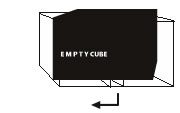PEDRO TUDELA
MAY, 12, 2011

CONTACTS
www.pedrotudela.org
interview @ arteinstitute.org/
http://www.arteinstitute.org/
vimeo.com/34509930
EXHIBITION INFORMATION
SUS-PENSO-EM-PAC
2011
four loudspeaker systems, belts, wood pallet, steel cables, stretchers, metallic springs, audio cables, amplifier and player, 60” cd in EMPTY CUBE (300x300x300 cm)
publication and/or replication.
The work that Pedro Tudela brings to EMPTY CUBE for a single presentation aggregates the vast diversity of approaches that make up his long and many-sided artistic career. Though recognised as a painter since the 1980s, over the last decade Tudela’s work has branched out into areas of artistic creativity that are very close to the concept of publication, in terms of his activities as a musician, phonographic publisher or sculptor with strong performative connotations, given that his sound installations affect the performativity of the space in which he operates, becoming action within the context out of which the work emerges.
‘Sus-penso-em-pac’ is a piece that started during the preparation of the physical space of EMPTY CUBE for receiving a work by another artist. This allowed Tudela to combine the taxonomy of the exhibition space with its links to the artistic practice, while recontextualising the whole memory of the work demanded by this exhibitive and curatorial project, displaying references to those various moments as a compacted correlate, a retrospective glance that is a recurring and updated factor in the construction of this project.
This work goes beyond the sound installation in the cube’s restricted space. Indeed, its title evokes for us a heterogeneous combination of interjections and adjectives that recontextualises the whole process, bringing to the spectator’s attention an apparent immobility that is almost redundant when we find ourselves confronted with the installation. However, the piece is first and foremost an occasion for updating the whole project, evoking its past history by setting itself up as an unrepeatable chance to condense, via visual and sound associations, the seriality, differentiation and personal experiences to which the ‘white cube’, as an historic exhibitive model, is subjected in a temporality that asynchronically predates the exhibition.
One of the essential conditions for this proposal is the placing of the cube in its habitual space, which allows it to invoke, without resorting to forthright quotation or appropriation, processes and strategies previously employed by other artists who, like Tudela, have questioned the rapport between the cube – as an intrusive exhibition space – and the Appleton Square gallery.
The following passage, by Pedro Tudela, is taken from a text written during the work process that shaped his project for EMPTY CUBE: ‘In this cube, we also find pre-notions that already carry out their narrative. A series of interventions by artists that cling to the simple, founding notion of receiving them. We have thus a result that combines what was thought, what has happened and the outcome of what is programmed. All this is considered part of the place’s history, but is also a work subject. What has happened remains in the memory of those who witnessed it and is mentioned or described, in more or less detail, to others who will create their own version of what once was. But what once was can be preserved via mechanisms that permit future reproduction, without letting the more exclusive part of description have a greater presence or influence on the image that is formed. I am referring, for instance, to video and audio recorders as devices that store and replicate a time analogous to a time already past, at the moment in which the capture took place. The object/cube is exposed right from the day in which it was imagined. Exposed because it is open to new ways of thinking it, exposed because it is presented, because it is narrated, because it is exposed!’
‘Sus-penso-em-pac’ is a random generator of composite elements that wander through the memory of those who have followed the growth of EMPTY CUBE, and is at the same time a synthetic, operative piece on the conditions created for every artistic action that has taken place there. This work is not ideologically affiliated with recycling as a principle of salvage, drawing sustenance instead from an internal structure founded on conceptual tools akin to musical composition and publication. Modulation, time, replication and rhythm delineate the whole convocation space suspended in the built sculptural object inside the cube. From the artist’s studio to the sound studio. Could we simply say ‘from studio to studio’?
João Silvério
May 2011





